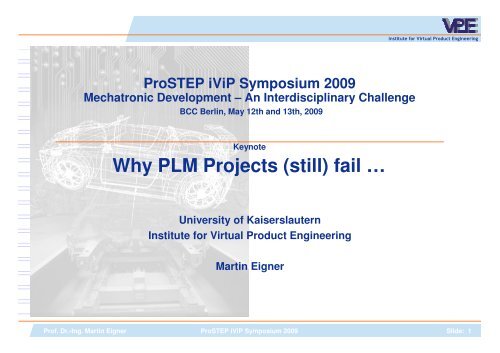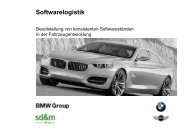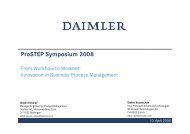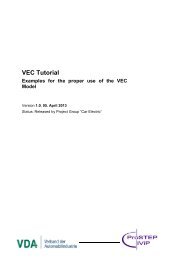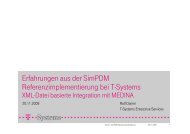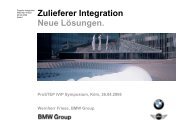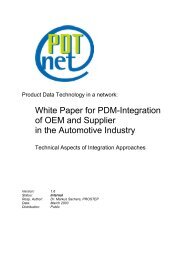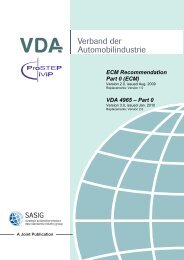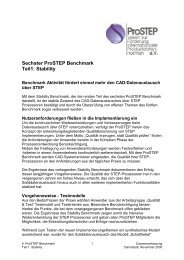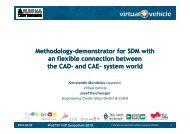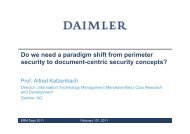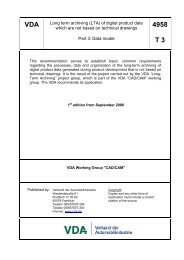Why PLM Projects Fail - ProSTEP iViP
Why PLM Projects Fail - ProSTEP iViP
Why PLM Projects Fail - ProSTEP iViP
You also want an ePaper? Increase the reach of your titles
YUMPU automatically turns print PDFs into web optimized ePapers that Google loves.
Institute for Virtual Product Engineering<br />
<strong>ProSTEP</strong> <strong>iViP</strong> Symposium 2009<br />
Mechatronic Development – An Interdisciplinary Challenge<br />
BCC Berlin, May 12th and 13th, 2009<br />
Keynote<br />
<strong>Why</strong> <strong>PLM</strong> <strong>Projects</strong> (still) fail …<br />
University of Kaiserslautern<br />
Institute for Virtual Product Engineering<br />
Martin Eigner<br />
Prof. Dr.-Ing. Martin Eigner <strong>ProSTEP</strong> <strong>iViP</strong> Symposium 2009 Slide: 1
Institute for Virtual Product Engineering<br />
<strong>ProSTEP</strong> <strong>iViP</strong> Symposium 2009<br />
<strong>Why</strong> <strong>PLM</strong> <strong>Projects</strong><br />
(still) fail<br />
… an engineered<br />
representation!<br />
…<br />
Product Lifecycle Management – What do we talk about?<br />
Complexity of Products and Processes<br />
What´s going wrong with the <strong>PLM</strong> Implementation ?<br />
Conclusion<br />
Prof. Dr.-Ing. Martin Eigner <strong>ProSTEP</strong> <strong>iViP</strong> Symposium 2009 Slide: 2
Product Lifecycle Management<br />
Product Lifecycle Management - Framework<br />
Complexity of Products and Processes Integrated Holistic Concept Conclusion<br />
Institute for Virtual Product Engineering<br />
<br />
Federated, multidisciplinary and integrated product creation and process<br />
support.<br />
Disciplines<br />
Services<br />
user accepted<br />
multidisciplinary<br />
Software<br />
Electronics<br />
Mechanics<br />
OEM<br />
1./2. Tier<br />
SME<br />
SME<br />
Product Creation<br />
Network<br />
Product<br />
Product<br />
planning Concept<br />
development Production Operation Recycling<br />
integrated<br />
federated<br />
Product Lifecycle<br />
Prof. Dr.-Ing. Martin Eigner <strong>ProSTEP</strong> <strong>iViP</strong> Symposium 2009 Slide: 3
Product Lifecycle Management<br />
Complexity of Products and Processes Integrated Holistic Concept Conclusion<br />
IT Solutions & <strong>PLM</strong> Implementation<br />
Institute for Virtual Product Engineering<br />
Source: Aberdeen 2006<br />
Source: AMR Research 2006<br />
Source: Deloitte Research – Mastering Innovation, 2005<br />
Prof. Dr.-Ing. Martin Eigner <strong>ProSTEP</strong> <strong>iViP</strong> Symposium 2009 Slide: 4
Institute for Virtual Product Engineering<br />
<strong>ProSTEP</strong> <strong>iViP</strong> Symposium 2009<br />
<strong>Why</strong> <strong>PLM</strong> <strong>Projects</strong><br />
(still) fail<br />
… an engineered<br />
representation!<br />
…<br />
Product Lifecycle Management – What do we talk about?<br />
Complexity of Products and Processes<br />
What´s going wrong with the <strong>PLM</strong> Implementation ?<br />
Conclusion<br />
Prof. Dr.-Ing. Martin Eigner <strong>ProSTEP</strong> <strong>iViP</strong> Symposium 2009 Slide: 5
Product Lifecycle Management<br />
Complexity of Products and Processes Integrated Holistic Concept Conclusion<br />
Product Development has changed<br />
Institute for Virtual Product Engineering<br />
<br />
… to higher Product and Process Complexity!<br />
Producer<br />
Tool supplier<br />
(manufacturin<br />
g facilities)<br />
Globalization<br />
Reliability<br />
Quality Mgmt.<br />
New Role<br />
of Suppliers<br />
Customer<br />
Component<br />
supplier<br />
Product<br />
Complexity<br />
Time to<br />
Market<br />
Design<br />
for X<br />
TCO<br />
Governance/<br />
Compliance<br />
Prof. Dr.-Ing. Martin Eigner <strong>ProSTEP</strong> <strong>iViP</strong> Symposium 2009 Slide: 6
Product Lifecycle Management<br />
Mechatronic for Automotive: An interdisciplinary challenge<br />
Complexity of Products and Processes Integrated Holistic Concept Conclusion<br />
Institute for Virtual Product Engineering<br />
<br />
Mechatronic Product Development Challenges:<br />
Computing<br />
Mechanics<br />
Mechatronic<br />
Electronics<br />
Source: Aberdeen 2006<br />
Prof. Dr.-Ing. Martin Eigner <strong>ProSTEP</strong> <strong>iViP</strong> Symposium 2009 Slide: 7
Overall external Variance<br />
Institute for Virtual Product Engineering<br />
ARMREST<br />
ARM_DRV (Armrest Driver)<br />
ARM_none (none)<br />
SEAT_CVR<br />
SAD_VACH (Vachette leather)<br />
SAD_ALCN (Alcantara)<br />
SAD_TXTL (Textile)<br />
SEATS<br />
SEA_SPRT (Sport)<br />
SEA_NORM (Normal)<br />
STEERING<br />
STEER_R (RHD)<br />
STEER_L (LHD)<br />
COL_IN<br />
CLI_BLK (Black)<br />
CLI_CRM (Beige)<br />
CLI_GRY (Gray)<br />
DOORS<br />
2DOOR (2 Door)<br />
4DOOR (4 Door)<br />
SEAT_HEATING<br />
SEA_HEAT (Heating)<br />
SEA_none (none)<br />
SEAT_ADJUST<br />
SAD_ELM (El. Memory)<br />
SAD_ELE (Electrical)<br />
SAD_MNL (Manual)<br />
Quelle: Dr.-Ing. Mathias Zagel<br />
Var[…]<br />
=<br />
n<br />
∏<br />
i = 1<br />
(OPT i<br />
)<br />
n = Number of options<br />
i = Index<br />
OPT i<br />
= Values for option i<br />
2*3*3*2*2*2*2*3 = 864<br />
Descriction<br />
incomplete<br />
Design for Variants 8<br />
Prof. Dr.-Ing. Martin Eigner <strong>ProSTEP</strong> <strong>iViP</strong> Symposium 2009 Slide: 8
Product Lifecycle Management<br />
Automotive Product and Process Network<br />
Complexity of Products and Processes Integrated Holistic Concept Conclusion<br />
Institute for Virtual Product Engineering<br />
In the 80s In den the80er 80sJahren<br />
In the 90s In den 90er Jahren<br />
Today<br />
Heute<br />
M2<br />
Lieferant Supplier 1<br />
Lieferant Supplier 2<br />
Lieferant Supplier 3<br />
Lieferant Supplier 4<br />
Lieferant Supplier n<br />
OEM<br />
Tier 3 Tier 2<br />
Tier 1<br />
OEM<br />
Tier 3 Tier 2<br />
Tier 1<br />
OEM<br />
M1<br />
M3<br />
}<br />
Continuous information<br />
Networks<br />
OEM 1<br />
Logistics service<br />
provider<br />
OEM ...n<br />
Service provider in the<br />
development field<br />
Logistics service<br />
provider<br />
Technology experts<br />
System<br />
integrators<br />
Service provider in<br />
the development<br />
field<br />
In the future<br />
Component<br />
manufacturer<br />
System-integrator ...<br />
Service provider in<br />
the development<br />
field<br />
Logistics service<br />
provider<br />
Technology expert<br />
...<br />
Component<br />
manufacturer<br />
Quelle: Dr. Göschel, BMW Group<br />
Prof. Dr.-Ing. Martin Eigner <strong>ProSTEP</strong> <strong>iViP</strong> Symposium 2009 Slide: 9
Institute for Virtual Product Engineering<br />
<strong>ProSTEP</strong> <strong>iViP</strong> Symposium 2009<br />
<strong>Why</strong> <strong>PLM</strong> <strong>Projects</strong><br />
(still) fail<br />
… an engineered<br />
representation!<br />
…<br />
Product Lifecycle Management – What do we talk about?<br />
Complexity of Products and Processes<br />
No What´s solution goingso wrong far? – with One the integrated <strong>PLM</strong> Implementation holistic concept ?<br />
Conclusion<br />
Prof. Dr.-Ing. Martin Eigner <strong>ProSTEP</strong> <strong>iViP</strong> Symposium 2009 Slide: 10
Product Lifecycle Management<br />
Complexity of Products and Processes Integrated Holistic Concept Conclusion<br />
No solution so far?<br />
Institute for Virtual Product Engineering<br />
<br />
Typical PDM/<strong>PLM</strong> scenarios<br />
- Jump as a tiger … land as a carpet runner<br />
- No vision no budget, vision but no budget, no vision but budget<br />
- No Champion, no leadership<br />
- My<strong>PLM</strong> = „I need my own PDM/<strong>PLM</strong> Solution“<br />
- To many own developed or over customized PDP/<strong>PLM</strong> solutions<br />
- Missing milestone plan, missing long term perspective<br />
- Redundancy, overlapping with legacy systems (f.e. ERP)<br />
- No PDM/<strong>PLM</strong> awareness on management level („no father, no mother“)<br />
- Wrong people to execute the PDM/<strong>PLM</strong> project<br />
- No balance between central defined and executed functions (f.e. engineering item<br />
master, ECM process, multi-disciplinary E-BOM) and flexible regional, product or<br />
discipline dependent solutions (f.e. TDM,....)<br />
- Customers want 150%, suppliers promise 120% and deliver 68%<br />
- IT drives processes and not vice versa.....<br />
- Detailed analysis of technique (System A 3,34 points, System B 3,29 points,...)<br />
- Missing user acceptance<br />
Prof. Dr.-Ing. Martin Eigner <strong>ProSTEP</strong> <strong>iViP</strong> Symposium 2009 Slide: 11
Product Lifecycle Management<br />
General comments (1): Profit Outlook and Result<br />
Complexity of Products and Processes Integrated Holistic Concept Conclusion<br />
Institute for Virtual Product Engineering<br />
<br />
What is the optimal relationship between effort and result?<br />
Result<br />
100%<br />
With 20% effort<br />
80% results<br />
Optimal <strong>PLM</strong> Point<br />
Effort<br />
Prof. Dr.-Ing. Martin Eigner <strong>ProSTEP</strong> <strong>iViP</strong> Symposium 2009 Slide: 12
Product Lifecycle Management<br />
General comments (2): Point of Organisation<br />
Complexity of Products and Processes Integrated Holistic Concept Conclusion<br />
Institute for Virtual Product Engineering<br />
<br />
Where is the optimal point of organisation?<br />
Costs<br />
Cost of Organisation (integrated)<br />
Total Cost integrated Enterprise<br />
Optimal <strong>PLM</strong> Point<br />
Autonomy Cost<br />
0 1<br />
Technical Organisation<br />
Prof. Dr.-Ing. Martin Eigner <strong>ProSTEP</strong> <strong>iViP</strong> Symposium 2009 Slide: 13
Product Lifecycle Management<br />
General comments (3): How to survive the critical phase?<br />
Complexity of Products and Processes Integrated Holistic Concept Conclusion<br />
Institute for Virtual Product Engineering<br />
<br />
The benefit of PDM/<strong>PLM</strong> is on other cost center and ROI > 2,5 Years<br />
Cost | Benefit<br />
Benefit PDM/<strong>PLM</strong><br />
Reference Line<br />
Cost PDM/<strong>PLM</strong><br />
0<br />
Zeithorizont<br />
Prof. Dr.-Ing. Martin Eigner <strong>ProSTEP</strong> <strong>iViP</strong> Symposium 2009 Slide: 14
Product Lifecycle Management<br />
Complexity of Products and Processes Integrated Holistic Concept Conclusion<br />
<strong>PLM</strong> Implementation „Triangle“<br />
Institute for Virtual Product Engineering<br />
<br />
<strong>PLM</strong> Implementation … is a Change Process / with sustainability!<br />
Technical Factor<br />
- correct requirements<br />
- chosen IT – solution<br />
- applications with growing complexity<br />
- software architecture<br />
… - one integrated holistic concept!<br />
Technical<br />
Factor<br />
Process<br />
Factor<br />
Human<br />
Human Factor<br />
Factor<br />
Process Factor<br />
- Business Processes<br />
- Operative Processes<br />
- PDM/<strong>PLM</strong> Project Management<br />
Human Factor<br />
- culture, values, beliefs…<br />
- skills, competencies…<br />
- motivation & BEHAVIOUR<br />
Prof. Dr.-Ing. Martin Eigner <strong>ProSTEP</strong> <strong>iViP</strong> Symposium 2009 Slide: 15
Technical Factors are not as important as supposed!<br />
Product Lifecycle Management Complexity of Products and Processes Integrated Holistic Concept Conclusion<br />
What is the appropriated class of PDM/<strong>PLM</strong> solutions:<br />
Institute for Virtual Product Engineering<br />
- high end interdisciplinary PDM/<strong>PLM</strong> solutions with high degree of customization<br />
- midrange PDM/<strong>PLM</strong> solution<br />
- TDM (team data management) solution tightly bundled with authoring systems<br />
<br />
What is the right PDM/<strong>PLM</strong> system?<br />
- The supplier must be able to survive and to execute!<br />
- The PDM/<strong>PLM</strong> functions are driven from the engineering processes (see next<br />
chapter)<br />
- Functions in one class of solutions are similar but differences in customization<br />
<br />
Customization Cost to high<br />
- Software / Application<br />
- Hardware (HW) + HW-near Software<br />
- Unique Services<br />
- Customizing Services (implementation of customer needs)<br />
- Data Migration (from legacy systems to central PDM system)<br />
- Annual maintenance<br />
Prof. Dr.-Ing. Martin Eigner <strong>ProSTEP</strong> <strong>iViP</strong> Symposium 2009 Slide: 16
Product Lifecycle Management<br />
Alternative PDM/<strong>PLM</strong> System Architecture<br />
Complexity of Products and Processes Integrated Holistic Concept Conclusion<br />
Institute for Virtual Product Engineering<br />
Different site specific ERP instances<br />
Authoring<br />
Systems<br />
TDM<br />
Systeme<br />
PDM/<strong>PLM</strong><br />
Backbone<br />
ERP<br />
Project Mgmt. Req. Mgmt. M-CAD EE-CAD SW/CASE Office ……..<br />
Prof. Dr.-Ing. Martin Eigner <strong>ProSTEP</strong> <strong>iViP</strong> Symposium 2009 Slide: 17
Costs for <strong>PLM</strong> System introduction<br />
Institute for Virtual Product Engineering<br />
<br />
Repartition of overall <strong>PLM</strong> introduction costs:<br />
<br />
Repartition of Customizing costs:<br />
Prof. Dr.-Ing. Martin Eigner <strong>ProSTEP</strong> <strong>iViP</strong> Symposium 2009 Slide: 18
Product Lifecycle Management<br />
Complexity of Products and Processes Integrated Holistic Concept Conclusion<br />
Process Drives IT and not Vice Versa<br />
Institute for Virtual Product Engineering<br />
Business Strategy / Vision<br />
LEGAL<br />
TECHNOLOGY<br />
PLANNING<br />
BRAND<br />
ALLIANCE<br />
Targets<br />
Results<br />
DESIGN<br />
OTHER<br />
Operativ Level ( f.e. PDP)<br />
Process-<br />
Requirements<br />
Process Model<br />
System Concept<br />
Ressources<br />
Detailled Level ( f.e. CM)<br />
System<br />
anforderungen<br />
Process<br />
Tests<br />
Einsatz<br />
Hardware<br />
IT-Solutions<br />
+<br />
Derivate the corresponding PDM/<strong>PLM</strong> functions and architecture<br />
Requirements<br />
Software<br />
System 1<br />
System 2<br />
Prof. Dr.-Ing. Martin Eigner <strong>ProSTEP</strong> <strong>iViP</strong> Symposium 2009 Slide: 19
Product Lifecycle Management Complexity of Products and Processes Integrated Holistic Concept Conclusion<br />
<strong>PLM</strong> Matrix and Process Oriented Approach<br />
Institute for Virtual Product Engineering<br />
Input from<br />
Porsche Consulting<br />
Input from Miele<br />
(Business/IT Strategy)<br />
Data model<br />
process analysis<br />
process<br />
documentation on<br />
“integration level” with<br />
<strong>PLM</strong>-relevant<br />
Information (using<br />
process modeling tool<br />
OMEGA)<br />
phase 1 phase 2 phase 3<br />
process<br />
optimization<br />
focusing on <strong>PLM</strong> (IT)<br />
aspects<br />
focusing on<br />
department<br />
“Wäschehandling”<br />
architecture<br />
analysis<br />
determination of<br />
requirement of <strong>PLM</strong><br />
processes, <strong>PLM</strong><br />
functionalities and <strong>PLM</strong><br />
architectures<br />
X<br />
X X<br />
X<br />
X<br />
phase 4<br />
architecture<br />
synthesis<br />
<strong>PLM</strong> vision<br />
<strong>PLM</strong> architectures<br />
<strong>PLM</strong> roadmap<br />
X<br />
X<br />
X<br />
PDM/<strong>PLM</strong><br />
roadmap<br />
Process<br />
System<br />
Organization<br />
Different data<br />
models for CAI<br />
Different data<br />
models for CAD<br />
Role<br />
Functionailty<br />
Role 1<br />
Role 2<br />
Role 3<br />
Role 4<br />
…<br />
Functionality 1<br />
Functionaltiy 2<br />
Functionaltiy 3<br />
Functionaltiy 4<br />
Functionaltiy 5<br />
Functionaltiy 6<br />
Functionaltiy 7<br />
Functionaltiy 8<br />
Functionaltiy 9<br />
Functionaltiy 10<br />
…<br />
Process 1<br />
Process 2<br />
Process 3<br />
Process 4<br />
Process 5<br />
Process 6<br />
…<br />
Layer<br />
Process<br />
Autoren -<br />
systeme<br />
TDM PDM ERP<br />
Data model for<br />
PDM<br />
Datenmodelle<br />
Data model for<br />
ERP<br />
Department<br />
R&D<br />
Department<br />
Product Development<br />
Department<br />
Production Planning<br />
Different data models for CAE/SE<br />
Department<br />
QM<br />
data models for<br />
CAP<br />
data models for<br />
CAM<br />
data models for<br />
CAQ<br />
CAI CAD CAE CASE<br />
CAP CAM CAQ<br />
Autoren -<br />
systeme<br />
Department<br />
IT for Engineering A<br />
Department<br />
IT for Engineering B<br />
Department<br />
IT for Production<br />
TDM PDM ERP<br />
Department<br />
IT for<br />
Engineering A<br />
Organisation<br />
Smaragd<br />
Smaragd<br />
Smaragd<br />
CAI CAD CAE CASE<br />
CAP CAM CAQ<br />
Autoren -<br />
systeme<br />
Aktivität<br />
TDM PDM ERP<br />
IT-Systeme<br />
File Server<br />
DOORS<br />
Excel<br />
Dialog E/P<br />
iPPE- SAP<br />
Smaragd<br />
Prisma<br />
V5 SOA<br />
Windchill<br />
CATIA<br />
ProE<br />
Smaragd<br />
Prisma<br />
V5 SOA<br />
Windchill<br />
CATIA<br />
ProE<br />
Dialog E/P<br />
iPPE- SAP<br />
Smaragd<br />
Prisma<br />
System A<br />
System B<br />
System A<br />
System B<br />
Dialog E/P<br />
iPPE- SAP<br />
Prisma<br />
Delmia<br />
System C<br />
Delmia<br />
System C<br />
Dialog E/P<br />
iPPE-SAP<br />
Prisma<br />
System D<br />
System E<br />
System D<br />
System E<br />
CAD CAE CASE<br />
CAI CAP CAM CAQ<br />
Prisma<br />
System F<br />
System G<br />
System F<br />
System G<br />
Autoren -<br />
systeme<br />
Aktivität<br />
TDM PDM ERP<br />
Aktivität Aktivität<br />
Aktivität<br />
Aktivität<br />
Aktivität<br />
Aktivität<br />
Aktivität Aktivität<br />
Aktivität<br />
Aktivität<br />
Aktivität<br />
Aktivität<br />
Aktivität<br />
Aktivität<br />
Aktivität<br />
Aktivität<br />
Aktivität Aktivität<br />
Aktivität<br />
Aktivität<br />
Aktivität<br />
Prozesse<br />
Aktivität<br />
Aktivität<br />
Aktivität<br />
Aktivität Aktivität Aktivität<br />
Aktivität Aktivität Aktivität<br />
Aktivität<br />
Aktivität<br />
Aktivität<br />
Aktivität<br />
Aktivität Aktivität<br />
Aktivität<br />
Aktivität<br />
<strong>PLM</strong> Schichten<br />
CAD CAE CASE<br />
CAI CAP CAM CAQ<br />
Produktlebenszyklus<br />
X X<br />
X<br />
X<br />
X<br />
X<br />
X<br />
X<br />
X<br />
X<br />
X<br />
X X<br />
X<br />
X X X<br />
X<br />
X X<br />
X<br />
X<br />
X<br />
X<br />
X X<br />
X<br />
X X X<br />
X<br />
X<br />
X<br />
X<br />
X<br />
X<br />
<strong>PLM</strong> Matrix<br />
…<br />
BOM ERP/MRP<br />
PDM <strong>PLM</strong> Backbone<br />
TDM<br />
Authoring System<br />
Prof. Dr.-Ing. Martin Eigner <strong>ProSTEP</strong> <strong>iViP</strong> Symposium 2009 Slide: 20
Product Lifecycle Management<br />
Complexity of Products and Processes Integrated Holistic Concept Conclusion<br />
Alternative System Architecture ECM<br />
Institute for Virtual Product Engineering<br />
Different site specific ERP instances<br />
ERP<br />
PDM/<strong>PLM</strong><br />
Backbone<br />
Engineering Change Management<br />
Defined process driven Interface<br />
TDM<br />
Systeme<br />
Open, flexible, departmental or discipline oriented implementation<br />
Authoring<br />
Systems<br />
Project Mgmt. Req. Mgmt. M-CAD EE-CAD SW/CASE Office ……..<br />
Publication Execution Synchronization<br />
Prof. Dr.-Ing. Martin Eigner <strong>ProSTEP</strong> <strong>iViP</strong> Symposium 2009 Slide: 21
Product Lifecycle Management<br />
Complexity of Products and Processes Integrated Holistic Concept Conclusion<br />
Human Factor<br />
Institute for Virtual Product Engineering<br />
<br />
Think about the Following Scenario…<br />
- … you have the perfect <strong>PLM</strong> solution - in your eyes…<br />
Timeline met<br />
Budget met<br />
System and its interfaces<br />
are working<br />
- … but the users don’t make use of the system yet!<br />
<br />
What could be the reasons for this?<br />
Prof. Dr.-Ing. Martin Eigner <strong>ProSTEP</strong> <strong>iViP</strong> Symposium 2009 Slide: 22
Product Lifecycle Management<br />
Complexity of Products and Processes Integrated Holistic Concept Conclusion<br />
The Reasons can be manifold…<br />
Institute for Virtual Product Engineering<br />
- System causes more – or new –<br />
work procedures.<br />
- Common behavior needs to be<br />
changed.<br />
- Personal expectations are not met.<br />
- Users don‘t know how to work with<br />
the system.<br />
- A general resistance to changes<br />
- Transparency of knowledge and/or<br />
behavior.<br />
- System does not help to fulfill<br />
business goals…<br />
- Management awareness not<br />
existent<br />
<br />
Good news: Most of this can be<br />
covered with Change Management<br />
– from the projects beginning on!<br />
Prof. Dr.-Ing. Martin Eigner <strong>ProSTEP</strong> <strong>iViP</strong> Symposium 2009 Slide: 23
Product Lifecycle Management<br />
Success Formula for PDM/<strong>PLM</strong> Introduction<br />
Complexity of Products and Processes Integrated Holistic Concept Conclusion<br />
Institute for Virtual Product Engineering<br />
- Analysis of Change Management needs for the PDM/<strong>PLM</strong> project<br />
- Make sure that the system meets your business needs!<br />
- Implement and live! a consequent project management<br />
- Clear definition of project goals, requirements and scope of the system<br />
- Solide consensus about project goals between business and IT<br />
- Involve key people (Users and Management)<br />
- Make the system as less complex as possible and as complex as needed – focus<br />
on essentials!<br />
- Realistic information and communication! Less is more…<br />
- Plan the system implementation with information, training and multipliers in the<br />
business<br />
- Evaluate the implementation and learn from it!<br />
- Mistakes are ok if you learn from them!<br />
S = 100E + 100P + T<br />
Source: Bowler | Rhode (1995)<br />
S = Success in implementing a system<br />
E = Empowered trained and motivated people<br />
P = Having defined the processes<br />
T = Particular technology<br />
Prof. Dr.-Ing. Martin Eigner <strong>ProSTEP</strong> <strong>iViP</strong> Symposium 2009 Slide: 24
Institute for Virtual Product Engineering<br />
<strong>ProSTEP</strong> <strong>iViP</strong> Symposium 2009<br />
<strong>Why</strong> <strong>PLM</strong> <strong>Projects</strong><br />
(still) fail<br />
… an engineered<br />
representation!<br />
…<br />
Product Lifecycle Management – What do we talk about?<br />
Complexity of Products and Processes<br />
No solution so far? – One integrated holistic concept<br />
VPE Conclusion – „Für Produkte und Prozesse von Morgen“<br />
Prof. Dr.-Ing. Martin Eigner <strong>ProSTEP</strong> <strong>iViP</strong> Symposium 2009 Slide: 25
Product Lifecycle Management<br />
Complexity of Products and Processes Integrated Holistic Concept Conclusion<br />
Conclusion<br />
Institute for Virtual Product Engineering<br />
<br />
<br />
<br />
<br />
<br />
<br />
<br />
<br />
<br />
<br />
<br />
Processes are more important than Technique<br />
Human factor are as important as Processes<br />
Technical and “political” balance of the System Architecture<br />
Management Awareness absolutely necessary<br />
ROI Calculation not only before implementation<br />
To plan the “Elephant” but to execute thin slices<br />
80% result with 20% effort is good<br />
No “over customization”<br />
No “over organization”<br />
Guarantee upward compatibility<br />
Guarantee Acceptance<br />
Prof. Dr.-Ing. Martin Eigner <strong>ProSTEP</strong> <strong>iViP</strong> Symposium 2009 Slide: 26
Thank you for your kind attention!<br />
Institute for Virtual Product Engineering<br />
Prof. Dr.-Ing. Martin Eigner<br />
Head of Institute VPE<br />
Contact:<br />
Institute for<br />
Virtual Product Engineering<br />
University of Kaiserslautern<br />
P.O.Box 3049<br />
67653 Kaiserslautern<br />
Germany<br />
Prof. Dr.-Ing. Martin Eigner <strong>ProSTEP</strong> <strong>iViP</strong> Symposium 2009 Slide: 27


